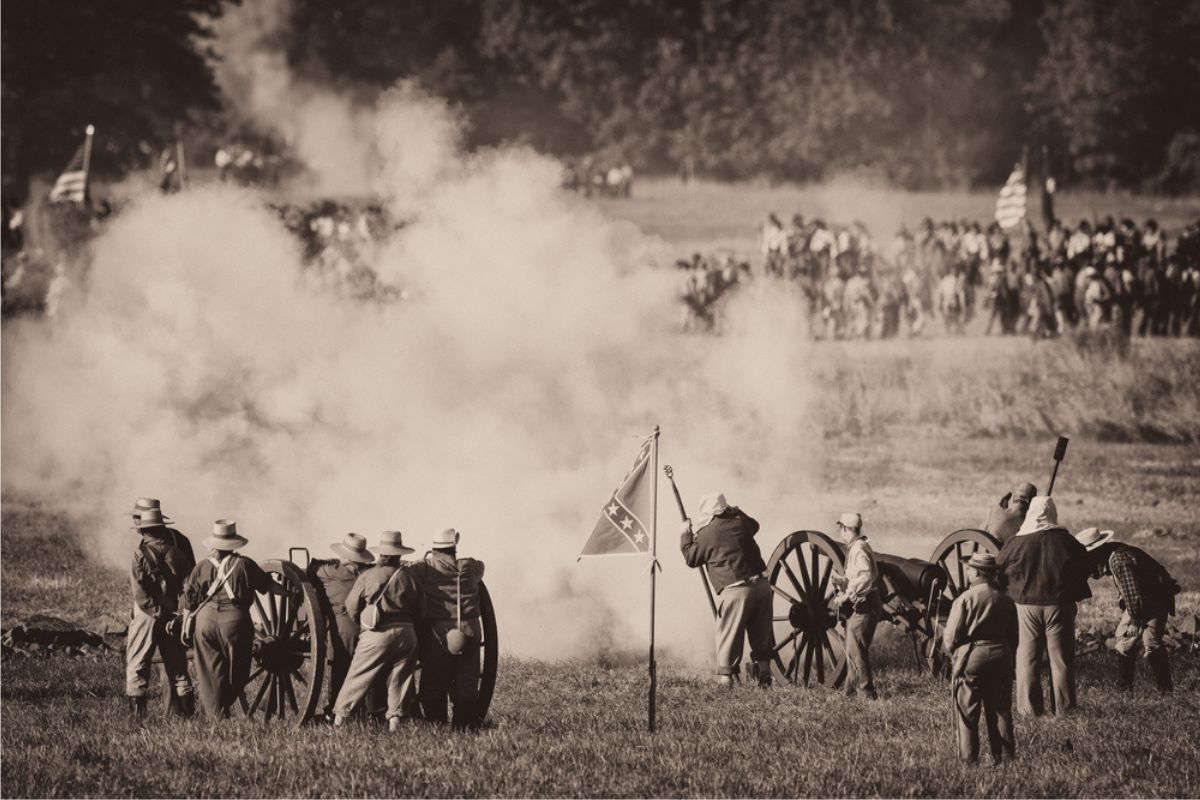The American Civil War was a significant armed conflict that occurred in the United States from 1861 to 1865. It was fought between the Northern states, known as the Union, and the Southern states that seceded and formed the Confederacy.
The primary cause of the war was the issue of slavery, with the Southern states fighting to preserve the institution, while the Union sought to abolish it.
The war had a profound impact on the nation, resulting in immense loss of life, social and political upheaval, and the eventual preservation of the Union.
It marked a turning point in American history and brought about significant changes in the country’s social, economic, and political landscape.
| Year | Events |
|---|---|
| 1861 | Attack on Fort Sumter, Start of the Civil War |
| President Lincoln’s call for volunteers | |
| First Battle of Bull Run | |
| 1862 | Battle of Shiloh |
| Second Battle of Bull Run | |
| Battle of Antietam | |
| Battle of Stones River | |
| 1863 | Emancipation Proclamation |
| Battle of Chancellorsville | |
| Battle of Gettysburg | |
| Gettysburg Address | |
| 1864 | Battle of the Wilderness |
| Juneteenth | |
| Battle of Atlanta | |
| Siege of Atlanta | |
| 1865 | General Lee’s surrender at Appomattox Court House |
| Assassination of President Lincoln | |
| Surrender of General Kirby Smith | |
| Ratification of the 13th Amendment |
Years of the Civil War
1861
The events of 1861 set the stage for the long and brutal conflict that would unfold over the next four years.
The attack on Fort Sumter and President Lincoln’s call for volunteers galvanized both the Confederacy and the Union, leading to increased mobilization and the escalation of hostilities.
Also Read: Facts About the Civil War
The First Battle of Bull Run demonstrated the complexity and intensity of the war, foreshadowing the challenging battles and campaigns that would follow.
1. Attack on Fort Sumter, April 12
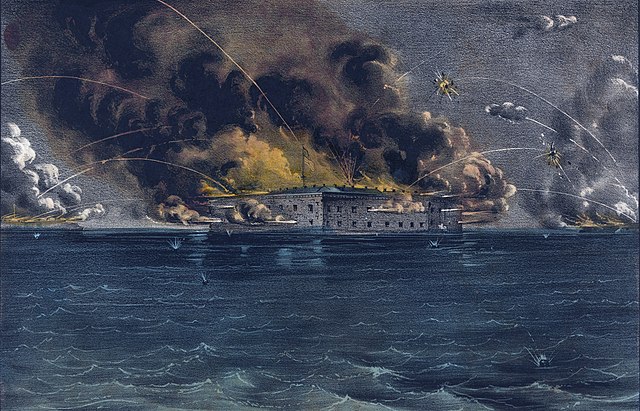
Attack on Fort Sumter, South Carolina: Confederate forces, under the command of General P.G.T. Beauregard, bombarded Fort Sumter, a Union fort located in the harbor of Charleston, South Carolina.
This attack marked the beginning of the Civil War as it was the first military engagement between the Union and the Confederacy.
2. President Abraham Lincoln’s call for 75,000 volunteers, April 15
In response to the attack on Fort Sumter, President Abraham Lincoln issued a proclamation calling for 75,000 volunteers from the state militias to suppress the rebellion and protect the Union. This proclamation sought to assemble troops to restore federal authority in the seceded states.
3. First Battle of Bull Run (First Battle of Manassas), July 21
Fought near Manassas, Virginia, this was the first major land battle of the Civil War. Union forces, commanded by General Irvin McDowell, engaged Confederate troops led by General P.G.T. Beauregard.
Also Read: Timeline of Abraham Lincoln
Initially, the Union made progress but was ultimately defeated by Confederate reinforcements under the command of General Thomas “Stonewall” Jackson.
The Confederate victory at Bull Run shattered the Union’s hope for a quick and decisive victory, and it highlighted the significance of the challenges ahead in the war.
1862
The events of 1862 showcased the intense and deadly nature of the Civil War.
Battles such as Shiloh, Second Bull Run, Antietam, and Stones River demonstrated the ferocity and determination of both Union and Confederate forces as they fought for control over strategic territories and sought to advance their respective causes.
The year 1862 was a critical period in the war, shaping the trajectory and outcomes of future campaigns.
1. Battle of Shiloh, April 6-7
Fought in southwestern Tennessee, this battle was one of the bloodiest in American history up to that point.
Union forces under General Ulysses S. Grant clashed with Confederate troops led by General Albert Sidney Johnston.
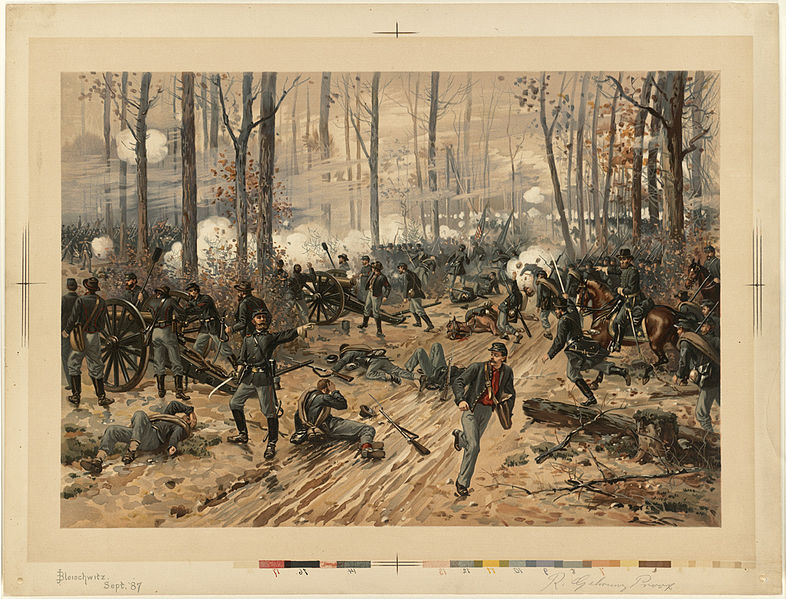
Though the Confederates initially gained ground, the Union forces held their position and emerged victorious, securing a crucial Union victory in the Western Theater.
2. Second Battle of Bull Run (Second Battle of Manassas), August 29-30
This battle took place near Manassas, Virginia, and was a significant Confederate victory. Confederate General Robert E. Lee’s forces defeated Union General John Pope’s Army of Virginia, leading to the Confederacy’s consolidation of power in Northern Virginia and setting the stage for their subsequent invasion of the North.
3. Battle of Antietam (Battle of Sharpsburg), September 17
Fought in Maryland, the Battle of Antietam was the bloodiest single-day battle in American history. Union forces under General George B. McClellan clashed with General Robert E. Lee’s Confederate Army of Northern Virginia.
The battle ended in a tactical draw but was considered a strategic Union victory as it forced Lee to retreat back into Virginia.
Antietam was a turning point in the war as it emboldened President Lincoln to issue the Emancipation Proclamation, declaring the abolition of slavery in Confederate-held territories.
4. Battle of Stones River (Battle of Murfreesboro), December 31
Fought in Tennessee, this battle was a brutal confrontation between Union forces commanded by General William S. Rosecrans and Confederate forces led by General Braxton Bragg.
The battle lasted for several days and resulted in heavy casualties on both sides. Ultimately, the Union forces emerged as the victors, securing control of Middle Tennessee.
1863
The events of 1863 demonstrated significant developments in the war. The Emancipation Proclamation reshaped the goals of the conflict and highlighted the issue of slavery.
The battles of Chancellorsville and Gettysburg showcased the ferocity and determination of both sides, with Gettysburg becoming a decisive Union victory.
The year also saw President Lincoln delivering one of the most iconic speeches in American history, further emphasizing the significance of the war and its larger ideals.
1. Emancipation Proclamation, January 1
President Abraham Lincoln issued the Emancipation Proclamation, declaring that all slaves in Confederate-held territories were to be set free.
While the proclamation did not immediately free all enslaved individuals, it shifted the focus of the war to include the abolition of slavery as a key objective and transformed the nature of the conflict.
2. Battle of Chancellorsville, May 1-4
Fought in Virginia, this battle saw Confederate General Robert E. Lee achieve a remarkable victory over Union General Joseph Hooker.
Lee’s audacious tactics, including splitting his forces and launching a surprise attack, resulted in a Confederate triumph.
However, the victory came at a significant cost with the loss of General Thomas “Stonewall” Jackson, who was mortally wounded during the battle.
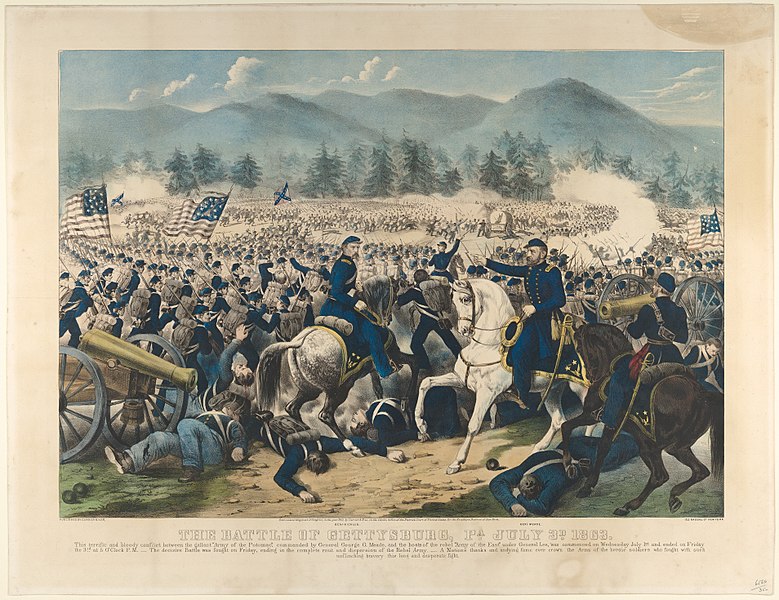
3. Battle of Gettysburg, July 1-3
One of the most famous and decisive battles of the Civil War, the Battle of Gettysburg was fought in Pennsylvania. Union forces, led by General George G. Meade, clashed with Confederate forces commanded by General Robert E. Lee.
The battle resulted in heavy casualties on both sides, but the Union emerged victorious, halting Lee’s invasion of the North. The Battle of Gettysburg is considered a turning point in the war and a major Union triumph.
4. Gettysburg Address, November 19
President Abraham Lincoln delivered the Gettysburg Address during the dedication of the Soldiers’ National Cemetery in Gettysburg, Pennsylvania.
In his short but powerful speech, Lincoln emphasized the principles of liberty, equality, and democracy, reiterating the importance of preserving the Union and honoring the sacrifice of those who fought in the Civil War.
1864
The of 1864 reflected the escalating intensity and strategic maneuvers of the war. The battles in Virginia, such as the Battle of the Wilderness, demonstrated the relentless fighting between Grant and Lee’s armies.
The Battle of Atlanta and its subsequent capture by Union forces were critical achievements for the Union, while the announcement of the emancipation of slaves in Texas on Juneteenth marked a significant advancement in the fight against slavery.
The year 1864 set the stage for the final campaigns and eventual conclusion of the Civil War in the following year.
1. Battle of the Wilderness, May 5-7
Fought in Virginia, this battle marked the beginning of Lieutenant General Ulysses S. Grant’s Overland Campaign against Confederate General Robert E. Lee.
The battle was characterized by intense fighting in dense woodland, resulting in heavy casualties.
Although the battle ended inconclusively, it set the stage for a series of fierce clashes between the Union and Confederate armies in the coming months.
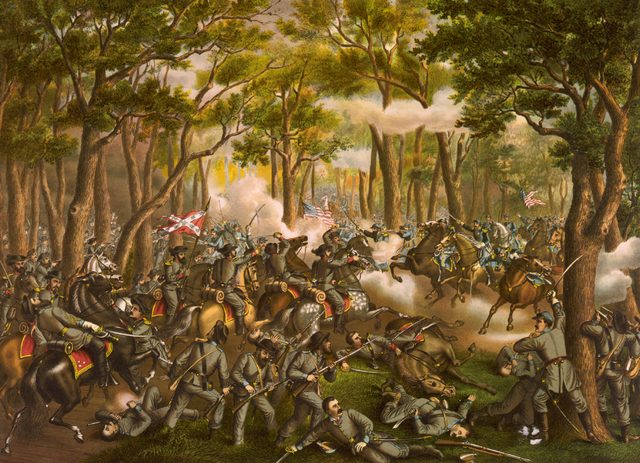
2. Juneteenth, June 19
Union General Gordon Granger announced the emancipation of slaves in Texas, effectively putting an end to slavery in the state.
Also Read: Facts About Juneteenth
This event marked a significant step towards the abolition of slavery throughout the United States.
3. Battle of Atlanta, July 22
Union forces, led by General William T. Sherman, attacked Confederate defenses outside Atlanta, Georgia. After a series of engagements, the Union army emerged victorious, capturing Atlanta on September 2.
The fall of Atlanta was a major blow to the Confederacy, as it was a crucial transportation hub and industrial center.
4. Siege of Atlanta Ends, September 2
Following the Battle of Atlanta, Union forces under General Sherman successfully completed their siege of the city, forcing Confederate General John B. Hood to evacuate. This Union victory boosted Northern morale and further weakened the Confederate war effort.
1865
The events of 1865 marked the culmination of the American Civil War and its aftermath. General Lee’s surrender at Appomattox Court House signaled the end of major Confederate resistance, while President Lincoln’s assassination cast a somber note on the war’s conclusion.
The surrender of General Kirby Smith and the ratification of the 13th Amendment further solidified the Union victory and the abolition of slavery.
The year 1865 brought about significant changes in the United States and set the stage for the process of Reconstruction and the challenges of healing a divided nation.
1. General Lee’s surrender at Appomattox Court House, April 9
Confederate General Robert E. Lee surrendered his Army of Northern Virginia to Union General Ulysses S. Grant at Appomattox Court House in Virginia.
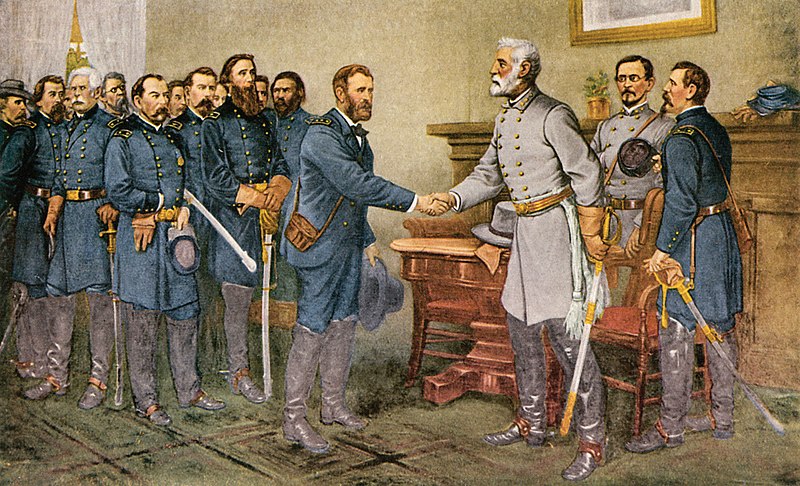
This surrender effectively ended the Civil War, as the most prominent Confederate army laid down its arms. The terms of surrender were generous, allowing Confederate soldiers to return home and keep their horses and sidearms.
2. Assassination of President Abraham Lincoln, April 14
President Abraham Lincoln was assassinated by John Wilkes Booth at Ford’s Theatre in Washington, D.C.
Lincoln’s death sent shock-waves throughout the nation and cast a shadow over the already fragile process of reconciliation and reconstruction following the war.
3. Surrender of General Kirby Smith, May 26
Confederate General Edmund Kirby Smith, the last major Confederate field commander, surrendered his forces in Galveston, Texas.
With his surrender, organized Confederate resistance effectively ceased, signaling the end of the Confederate States of America.
4. Ratification of the 13th Amendment, December 6
The Thirteenth Amendment to the United States Constitution was ratified. This amendment abolished slavery and involuntary servitude throughout the United States, finally fulfilling the promise of emancipation for all enslaved individuals.
These events of the American Civil War and its aftermath laid the groundwork for the modern United States as we know it today.
